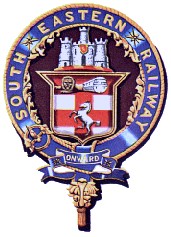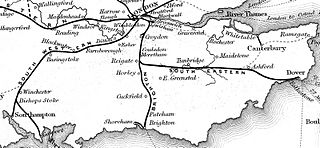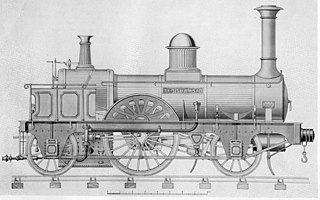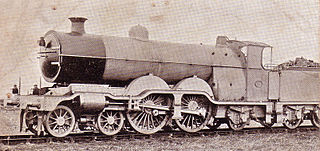
New Cross Gate is a railway station in New Cross, London, on the Brighton Main Line and the London Overground. It is 2 miles 70 chains down the line from London Bridge and is about 600 m (660 yd) west of New Cross station. It is in Travelcard Zone 2, and is operated by London Overground.

The Southern Railway (SR), sometimes shortened to 'Southern', was a British railway company established in the 1923 Grouping. It linked London with the Channel ports, South West England, South coast resorts and Kent. The railway was formed by the amalgamation of several smaller railway companies, the largest of which were the London and South Western Railway (LSWR), the London, Brighton and South Coast Railway (LB&SCR) and the South Eastern and Chatham Railway (SE&CR). The construction of what was to become the Southern Railway began in 1838 with the opening of the London and Southampton Railway, which was renamed the London & South Western Railway.

The London, Brighton and South Coast Railway was a railway company in the United Kingdom from 1846 to 1922. Its territory formed a rough triangle, with London at its apex, practically the whole coastline of Sussex as its base, and a large part of Surrey. It was bounded on its western side by the London and South Western Railway (L&SWR), which provided an alternative route to Portsmouth. On its eastern side the LB&SCR was bounded by the South Eastern Railway (SER)—later one component of the South Eastern and Chatham Railway (SE&CR)—which provided an alternative route to Bexhill, St Leonards-on-Sea, and Hastings. The LB&SCR had the most direct routes from London to the south coast seaside resorts of Brighton, Eastbourne, Worthing, Littlehampton and Bognor Regis, and to the ports of Newhaven and Shoreham-by-Sea. It served the inland towns and cities of Chichester, Horsham, East Grinstead and Lewes, and jointly served Croydon, Tunbridge Wells, Dorking and Guildford. At the London end was a complicated suburban and outer-suburban network of lines emanating from London Bridge and Victoria, and shared interests in two cross-London lines.

The South Eastern Railway (SER) was a railway company in south-eastern England from 1836 until 1922. The company was formed to construct a route from London to Dover. Branch lines were later opened to Tunbridge Wells, Hastings, Canterbury and other places in Kent. The SER absorbed or leased other railways, some older than itself, including the London and Greenwich Railway and the Canterbury and Whitstable Railway. Most of the company's routes were in Kent, eastern Sussex and the London suburbs, with a long cross-country route from Redhill in Surrey to Reading, Berkshire.
Chief mechanical engineer and locomotive superintendent are titles applied by British, Australian, and New Zealand railway companies to the person ultimately responsible to the board of the company for the building and maintaining of the locomotives and rolling stock. In Britain, the post of locomotive superintendent was introduced in the late 1830s, and chief mechanical engineer in 1886.
The London and Croydon Railway (L&CR) was an early railway in England. It opened in 1839 and in February 1846 merged with other railways to form the London, Brighton and South Coast Railway (LB&SCR).

The London and Brighton Railway (L&BR) was a railway company in England which was incorporated in 1837 and survived until 1846. Its railway ran from a junction with the London and Croydon Railway (L&CR) at Norwood – which gives it access from London Bridge, just south of the River Thames in central London. It ran from Norwood to the South Coast at Brighton, together with a branch to Shoreham-by-Sea.

Richard Edward Lloyd Maunsell held the post of chief mechanical engineer (CME) of the South Eastern and Chatham Railway from 1913 until the 1923 Grouping and then the post of CME of the Southern Railway in England until 1937. He had previously worked his way up through positions in other railways in Ireland, England and India.

Jenny Lind was the first of a class of ten steam locomotives built in 1847 for the London, Brighton and South Coast Railway (LB&SCR) by E. B. Wilson and Company of Leeds, named after Jenny Lind, who was a famous Swedish opera singer of the period. The general design proved to be so successful that the manufacturers adopted it for use on other railways, and it became the first mass-produced locomotive type. The "Jenny Lind" type was also widely copied during the late 1840s and 1850s, and into the 1860s.
William Stroudley was an English railway engineer, and was one of the most famous steam locomotive engineers of the nineteenth century, working principally for the London, Brighton and South Coast Railway (LB&SCR). He designed some of the most famous and longest-lived steam locomotives of his era, several of which have been preserved.

Brighton railway works was one of the earliest railway-owned locomotive repair works, founded in 1840 by the London and Brighton Railway in Brighton, England, and thus pre-dating the more famous railway works at Crewe, Doncaster and Swindon. The works grew steadily between 1841 and 1900 but efficient operation was always hampered by the restricted site, and there were several plans to close it and move the facility elsewhere. Nevertheless, between 1852 and 1957 more than 1200 steam locomotives as well as prototype diesel electric and electric locomotives were constructed there, before the eventual closure of the facility in 1962.
Thomas Kirtley was an English railway engineer, and was the locomotive superintendent of the North Midland Railway and later the London, Brighton and South Coast Railway.
Robert John Billinton was the Locomotive, Carriage, Wagon and Marine Superintendent of the London, Brighton and South Coast Railway from 1890 until his death.
Douglas Earle Marsh (1862–1933) was an English railway engineer, and was the Locomotive, Carriage and Wagon Superintendent of the London, Brighton and South Coast Railway from November 1904 until his early retirement on health grounds in July 1911.
Lawson ButzkopfskiBillinton was the Locomotive Engineer of the London, Brighton and South Coast Railway from 1912 until the company became part of the Southern Railway in 1923. He joined the LBSCR in 1900 as an apprentice. By the end of 1907 he was a district locomotive superintendent at the railway works at New Cross. From February 1911 Billinton was locum tenens, or caretaker, for Locomotive Engineer D. E. (Earle) Marsh at Brighton works whilst Marsh was on leave of absence due to ill health. Earle Marsh resigned in July 1911. Billinton was promoted to Locomotive Engineer at the beginning of 1912.

John Chester Craven was an English locomotive engineer. He was the locomotive, carriage and wagon superintendent of the London, Brighton and South Coast Railway from 1847 until his resignation in 1870. He died in 1887.

The London, Brighton and South Coast Railway (LB&SCR) H1 class was a class of 4-4-2 steam locomotives for express passenger work. They were designed by D. E. Marsh and were built by Messrs Kitson and Company in 1905 and 1906.
James I'Anson Cudworth was an English railway engineer, and was Locomotive Superintendent of the South Eastern Railway (SER). He served in this capacity from 1845 to 1876. He is notable for designing a successful method for burning coal in steam locomotives without significant emission of smoke, and for introducing the 0-4-4T wheel arrangement to English railways.










